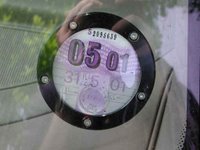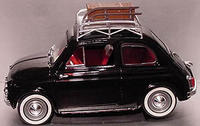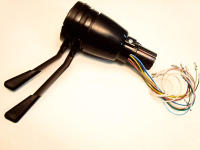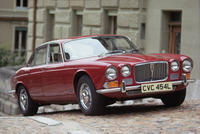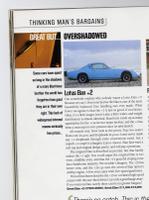
The next day was the 31st, New Years Eve. It was a beautiful, sunny, Alpine kind of day so we went to a snowy kids playground place at the top of the valley to let my girlfriend's little nephew run around and play for a while. That was fun - you basically walk in and there are sledges, inner tubes, skis, etc. just lying around - once you've paid your entrance you just walk in and do what you like! Unfortunately I was suffering from a bit of a dodgy back, otherwise I'd have done more, but oh well. Next time.
We weren't going anywhere that day, but we waited until the sun shone fully down the valley (doesn't happen until about 2pm because of the narrowing of the valley near the north end and the angle of the sun) and warmed the car up, then we "stirred the tanks" and took it for a little spin down to Introd to buy some petrol and a
grolla from a really pretty little wood-working shop in the village.
Satisfied everything seemed well, we returned the car to its spot on the hillside and set about enjoying the evening.
It was the usual affair of guitar, singing, chat, food, wine and general good fun. Then came midnight and we got champagne out and ate the
traditional lentils for luck. We chatted on until about 2am and decided to turn in for the night as we knew we had an early start and it was already late.
The next day it was really cold in the morning. We got up at about 8:30am, but we messed about for a while and I think we got down to the car for about 10am and got all our stuff packed again. This morning, I could already feel, was one of those mornings we'd be glad we bought jump leads. The poor little car wasn't going to be at all happy about waking up this morning in the sub-zero temperatures! Still, after a bit of bullying from the
alternator of a bigger, newer cousin, the little Fiat sprang in to life and we waved goodbye and set off down the valley towards Monte Bianco (or Mont Blanc, as it may be better known).
After an hour winding along a minor road towards the Mont Blanc tunnel (we weren't touching the motorways in Italy any more if we could help it), via
Courmayeur we arrived, had our passports checked and passed through in to the tunnel. All was well, we were in good spirits and about to cross the French border. But then disaster struck. About two thirds of the way along the
11.6 kilometre tunnel through the heart of the mountain we both started to smell petrol. Fresh petrol in fact, very strongly! At first I told myself it was the air but after a minute or two we both realised it was our car. We were both pretty calm as we knew we had to get out of the tunnel anyway, so we just kept driving. What else could we do?
We came out the other end of the tunnel, thankfully, and pulled in to the first lay-by we found! I leapt from the car and ran to the rear, shouting to stop the engine. I opened the engine compartment just in time to see the last of what was a stream of petrol evaporate off of the cylinder head with a sharp "fiissssss". A quick examination revealed that it wasn't serious - clearly something had rattled loose. However, stupidly we had no tools with us and it was New Years Day. It was time to make the call and hope the pan-European breakdown insurance was worth the money we paid for it.
We were a little worried at this point. We'd barely travelled 40 km, we were right up on the side of Mont Blanc, the cloud was thickening and it was freezing cold - the French side of the mountain gets practically no sun in winter and the temperature drop is significant. My girlfriend was already getting cold feet - literally and metaphorically - and we had no idea how long the breakdown truck would be. At first they said they would take the car in to a garage over night, but fortunately we managed to convince the operator at the insurance company that it was simply a couple of loose bolts, so as long as they sent someone with some spanners and spares who knew their way around an engine we'd be fine!
Fortunately, only an hour later a very nice French mechanic appeared, a short-haired chap with a no nonsense manner and a small tool box. We started the engine again for him and this time I was able to see the petrol in full flow! Frankly, I'm amazed enough petrol was still entering the carburetor to keep the engine going. It was pouring everywhere. It was difficult to tell where the petrol was actually coming from as it was spraying, but on a hunch the mechanic changed the clip holding the fuel line to the carburetor and that was that. We were on our way again.
The next stop was only about 3 km down the road at
Chamonix to see friends briefly before continuing. Unfortunately our unplanned brush with coldness had left us running behind schedule, so it was a quick hug, a chat and some photos and we were on our way again. Anxious about the time, and no longer in Italy, we took to the motorway once more. Fortunately it was down hill practically all the way out of the Alps from Chamonix, so we were able to keep our speed and didn't get in the way too much. That, coupled with the fact that French drivers are definitely much more courteous, made our motorway stretch reasonably uneventful.
One of the things I forgot to mention is that when you're doing long runs with these little air cooled engines at what passes for "speed", you need to stop for 10 minutes every 100 kms or so to give them a breather. They do get too hot otherwise and you can smell it. This isn't really a bad thing, since you can usually do with stretching your legs every hour and a half or so anyway. And so we crept along, swinging up past Geneva then stopped for lunch quite late about two thirds of the way between Geneva and the turn-off for Lyon. A motorway service station. They're the same all over the world. Globalisation in action. Except for one vital point. In France the food is at least edible.
As we left the service area it was getting dusky and I went very quiet. My girlfriend asked me what was wrong. I was starting to get the sensation that one might get if you lived in Transylvania and dusk was approaching. I wanted to bolt the doors and hang up the garlic! I didn't want to panic her, but I really didn't want to be on the motorway at night. During the day people can see you from a long way off. They can see you're driving a little old car and going slowly. At night all they see is two red dots in the distance. They assume you're going 120 kph like everyone else. They don't realise you're not until it's bordering on too late! This is
really dangerous.
I just said "we need to get off the motorway as soon as possible" and left it at that. And sure enough, it happened. We were about 10 minutes from the Lyon (South)/Reims (North) turn off when the sun finally dippped beneath the horizon and the witching hour began! We had never been so scared in our lives. I still swear it's the closest I've been to dying and known about it. I'm not joking, I'm deadly serious. All of a sudden the visibility goes and every 30 seconds someone screams up behind you with their headlamps on full beam, they realise how slowly you're going, slam on the brakes, beep and swerve then scream past you. You think every time this happens they're going to hit you. And you know that IF they hit you in this little tin box, you're dead. My girlfriend was on the edge of tears and we moved to the hard shoulder to continue - we weren't safe anywhere else - not even in the slow lane. We took the first exit we could find. It didn't matter where we were! It probably took about 5 minutes to get off the motorway, but it felt like an eternity. We finally got to a place where we could stop and we just sat there shaking for a minute, both of us thinking about what might have happened.
We never took the little car on an unlit motorway after dark again.
We arrived in a rather sad little town in the valley of the River Ain, with two hotels, both closed. However, we managed to realise that there was a fairly significant town called Bourg-En-Bresse about 20 km away up a minor road that ran parallel with the motorway. We set off, after getting some directions to make sure we were heading the right way, and arrived on the out-skirts. We tried 3 or 4 motels on the outskirts, all sad, all dirty and all fully booked. I was starting to despair but my girlfriend was not going to give up, so we headed in to town where, by chance, we found a nice hotel with a couple of rooms and within walking distance of the centre. We snapped up one of the rooms and dumped our bags. The hotelier told us that Bourg-En-Bresse was a very old and very pretty historical town. We figured he was a local and biased, but it sounded nice. And I have to say he was right. It is so nice it deserves an entry of its own.
 What happens when you take a standard Fiat 500, rip out everything, put the stripped bodyshell (with newly flared wheel arches, of course) back on a custom racing chassis and fit a super-light, 150bhp, Ducati 999R motorcycle engine in the boot? You have the F500, perhaps the most ridiculous supercar known to man.
What happens when you take a standard Fiat 500, rip out everything, put the stripped bodyshell (with newly flared wheel arches, of course) back on a custom racing chassis and fit a super-light, 150bhp, Ducati 999R motorcycle engine in the boot? You have the F500, perhaps the most ridiculous supercar known to man.